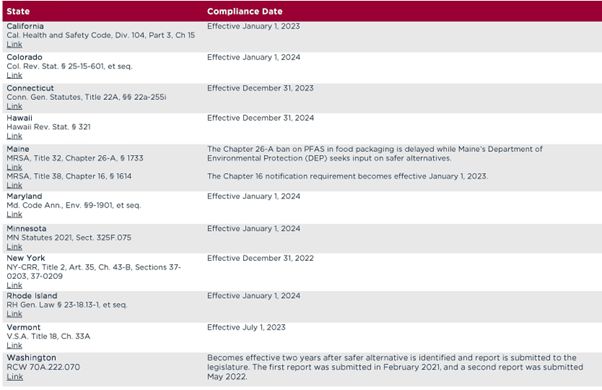- within Transport, Accounting and Audit and Immigration topic(s)
This article provides companies that are stakeholders in the food or food packaging industry with an overview of state activity surrounding laws banning or restricting the use of per- and polyfluoroalkyl substances (PFAS) in food packaging. The end of the year provides a natural opportunity to assess the status of previous state activity in this arena. But the end of 2022 also represents an important juncture because compliance obligations are fast approaching at the start of 2023 in a number of states. We summarize below some key high-level points that stakeholders need to keep front-of-mind with respect to these state laws. For further details, please feel free to contact us.
What States have Enacted Laws and/or Regulations Restricting the Use of PFAS in Food Packaging?
At this time, a total of 11 states have adopted some form of a law that outright bans or restricts the use of PFAS in food packaging applications, or that provides the state with a regulatory pathway to ban or restrict PFAS in food packaging: California, Colorado, Connecticut, Hawaii, Maine, Maryland, Minnesota, New York, Rhode Island, Vermont, Washington.
When do these State Laws Start to Come into Effect?
California and New York's PFAS food packaging ban laws come into effect at the start of 2023. A related law in Maine, which imposes notification obligations on companies that market products containing PFAS, also comes into effect January 1, 2023. Maine recently clarified that it interprets this notification requirement to apply to food packaging containing PFAS.1 Other states laws come into effect on a rolling basis. For example, Vermont's law comes into effect July 1, 2023, while several other states laws do not come into effect until January 1, 2024. Washington's law provides that a ban of food packaging containing PFAS cannot go into effect until the Washington Department of Ecology identifies safer alternatives that are available. The Department of Ecology already identified select categories of food packaging for which safer alternatives are available, with the first ban coming into effect in February of 2023 (covering plant-fiber based wraps, plates, food boats, and pizza boxes), and a second ban coming into effect in May of 2024 (covering plant-fiber based bags, bowls, flat service ware, open-top containers, and closed containers).
How are PFAS Defined in these State Laws?
The relevant state laws generally define "PFAS" as a "class of fluorinated organic chemicals that contain at least one fully fluorinated carbon atom, including perfluoroalkyl and polyfluoroalkyl substances." This broad definition covers, by many estimates, over 5,000 chemicals. This definition aligns with OECD's 2021 updated definition as follows: "PFASs are defined as fluorinated substances that contain at least one fully fluorinated methyl or methylene carbon atom (without any H/Cl/Br/I atom attached to it), i.e. with a few noted exceptions, any chemical with at least a perfluorinated methyl group (-CF3) or a perfluorinated methylene group (-CF2-) is a PFAS."2
How is Food Packaging Defined?
In determining the applicability of individual state laws to your products, it is critical to examine the way in which packaging is defined. Several state laws define "packaging" to include only packaging that is in direct contact with food, while others define packaging broadly to include items such as shipping containers and food handling gloves. In addition, many states limit their definition of food packaging to packaging that is comprised in substantial part of paper, paperboard, or other materials originally derived from plant fibers. (See the California, Colorado, Hawaii, Maryland, and New York laws, for example.)
What do We Need to Know About these State Laws from a Compliance Standpoint?
There are common themes that run throughout these laws and that drive compliance obligations. In many states, compliance obligations are determined by whether food packaging contains "intentionally added" or "intentionally introduced" PFAS to a product to have a functional or technical effect in the product. But, there are exceptions to the preceding statement. For example, California's law includes a unique provision for triggering compliance obligations based on whether a product contains "regulated PFAS," which include not only PFAS that a manufacturer has intentionally added to food packaging, but also includes food packaging that contains PFAS at or above 100 parts per million (ppm), as measured in total organic fluorine. Rhode Island's law contains a unique provision clarifying that PFAS used "as a processing agent, mold release agent or intermediate" is considered an intentional introduction.
Another important aspect of some state laws is whether alternatives to packaging containing PFAS are available. Certain states, i.e., Washington and Maine, authorize the banning of PFAS in food packaging only if a suitable alternative material is available. Labeling provisions also need to be considered; for example, California and Colorado require labeling for intentionally added chemicals in cookware.
Finally, some state laws, including the laws in Connecticut, Maryland, Rhode Island, and Vermont, include provisions regarding certificates of compliance. These provisions impose varying legal requirements. For example, companies are required to prepare certificates of compliance under the laws in Maryland and Rhode Island. The certificate of compliance provision in Connecticut's law requires that a certificate of compliance must be provided upon request to state authorities, but if a company can show that they relied in good faith on a certificate of compliance from their supplier, then the company will be deemed to not have violated the law.
Key Takeaways
Collectively, the emerging patchwork of state laws means that companies need to take care to assess the compliance of their products under each individual law. The nuances of the various laws and the potential for divergent compliance outcomes also complicates supply chain and distribution networks, given that it is very difficult to route food packaging or food to select states. Therefore, companies should become familiar with the individual state laws. The chart below provides a list of the state laws banning or restricting PFAS in food packaging and their effective dates. Steptoe's food-contact materials team has analyzed the key provisions of each of these laws and can assist you in determining their applicability to your products, and your obligations under these laws. Please contact us for more information.

Footnotes
1 PFAS in Products, Frequently Asked Questions, Maine Department of Environmental Protection, available at: https://www.maine.gov/dep/spills/topics/pfas/PFAS-products/index.html.
2Organization for Economic Co-operation and Development (OECD) "Reconciling Terminology of the Universe of Per- and Polyfluoroalky substances: Recommendations and Practical Guidance."
The content of this article is intended to provide a general guide to the subject matter. Specialist advice should be sought about your specific circumstances.





